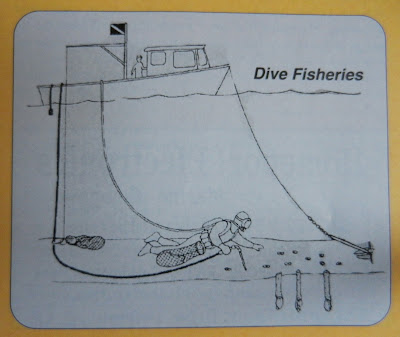 |
| Trident Seafoods Cannery, Petersburg |
 |
| Tonka Seafoods, Petersburg |
Commercial fishing is big business in
Petersburg with approximately 600 commercial fishing vessels. Fishermen in the area hold over 1,000 fishing
permits for a variety of fish sold to three major fish processing plants in
Petersburg: Tonka Seafoods, Trident
Seafoods Cannery, and Petersburg Fisheries.
Cold Storage facilities and marine supply stores are all part of the local
fishing industry at Petersburg with Salmon, Halibut, and
Crab being the main fisheries. I always found the various
names for Salmon confusing, that is until I saw a diagram in a Juneau visitors’ guide illustrating a clever way to remember the various species of
Salmon.
There are five different species
of salmon as shown in the diagram. Let’s
start with the thumb for Chum (nicknamed Dog and Keta); then a poke in the eye with
the pointer finger for Sockeye (nicknamed Red, as in a red eye); then the large
middle finger for Chinook (King); next comes the ring finger for Silver (or
Coho with two o’s for rings); and lastly the pinky finger for the Pink Salmon
(nicknamed Humpy); wow, no wonder I was confused! The five-finger naming game makes it easy.
More helpful diagrams were found in the
visitors’ guide for Petersburg, illustrating the various commercial
fishing vessels and techniques for each type of fishery: Longliners, Seiners, Trollers, Gillnetters, Crabbers,
and Dive Fisheries.
Longliners use
a long length of line with a series of hooks strung out across the ocean floor
to catch bottom dwelling fish such as halibut and black cod.
Seiners on-the-other-hand find a
school of fish, and then an open net is strung out using a skiff towing one end
of the net from the stern of the seiner and the seiner motors away holding the
other end. The boats then motor towards
each other in a circle, closing the net like a purse trapping large quantities
of Pink Salmon (Humpies), which are the primary product in the canned
salmon market.
I think the cooking
process is what we have been smelling every mid-afternoon while at Petersburg,
a foul smell but the smell of money nevertheless. Seiners are typically 58 feet in length and
among the largest vessels in the harbor and have a crew of four or more. I love the scenic photo opportunities they create when seen pulling up
their large nets from the stern.
Chinook
(Kings) are the big-money fish caught primarily by Trollers who run
multi-hook lines from poles lowered over the water from each side of the boat and motor slowly through the fishing grounds. I love taking photos of Trollers with their
arms extended while cruising through beautiful scenery or out at sea. Trollers also catch Silvers (Coho) which return later than Kings in the season to spawn and also bring a good price. Trollers should not be mistaken with Fishing
Trawlers (Draggers). Unlike Longliners
and Trollers which use lines with hooks, Fishing Trawlers use a cone-shaped net
drawn through the water near the sea bottom or mid-water level. In the world of pleasure craft, the word “trawler” refers to a
slow-moving pleasure boat such as Got d’
Fever along with other makes and models of fuel-efficient, slow-cruising pleasure boats.
Like the fish themselves, keeping track of the
types of fishing boats and techniques can be a challenge. Next are the Gillnetters which target
Sockeye (Reds), Chums (Dogs), and occasionally Silvers (Coho). Gillnetters use 150-fathom driftnets (900
feet) and pleasure boats need to give them a wide berth! Fish swim into the net strung out behind the
boat and their fins and gills become tangled in the net, hence gillnetters; the net with the entangled fish is then drawn into
the boat.
A Gillnet boat can be
identified by the large spool or reel at the rear used to free-wheel out the
net and haul in the fish. There are
currently 86 Gillnetters in Petersburg.
Crabbers
are also seen at the docks in Petersburg.
Crews of two or more use pots weighing around 45 pounds for Dungeness
crab and over 500 pounds for King crab. Buoys are used to mark the location of the dropped pots so they can be retrieved later.
Fresh crab and live-crab are
popular with restaurants worldwide and Alaskan crab are rated as the
finest.
Dive Fisheries is the
latest technique used to recover Abalone, Sea Cucumber, Geoducks, and Sea
Urchins from the sea bottom by divers using scuba gear or sometimes with
umbilical diving gear. Plucked from
between rocks or sandy sea floors, the harvest is placed in bags, buckets, or
netting and raised to the surface.
 |
| Petersburg Fisheries, a Division of Icicle Seafoods |
 |
| The Five Salmon Species |
 |
| Illustration of Longliners |
 |
| Longliner Fishing Vessel at Petersburg |
 |
| Illustration of Seiners |
 |
| Seiner Fishing Vessels at Petersburg |
 |
| Trolling Vessel with Arms Extended |
 |
| Illustration of Gillnetters |
 |
| Gillnetter at Petersburg |
 |
| Illustration of Crabbers |
 |
| Crabber Vessel at Petersburg |
 |
| Illustration of Dive Fisheries |
 |
| Fish and Fishing Seasons |
No comments:
Post a Comment